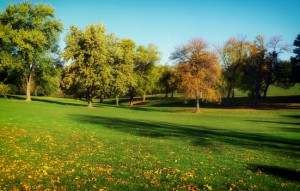Your grass may not be growing as fast as it was in the spring and summer, but it’s still important to take care of it. These tips will help you keep your lawn green longer, get the grass in shape to survive the winter and prevent common problems with weeds and mold.
Keep Watering and Mowing
In most parts of the country, precipitation and humidity decrease through the fall, requiring more water to keep your lawn healthy. Continue watering until temperatures dip below 40ºF or there’s snow coverage.
Grass growth will slow as temperatures drop, but it still needs to be kept at a healthy height. By late fall, your lawn may only need to be mowed once every two or three weeks with the final mow. At the end of the season, mow your lawn as short as possible without cutting into crowns. This keeps moisture from collecting after snowfalls that can lead to root damage and snow mold.
Stop Broadleaf Weeds
Broadleaf varieties like dandelions and white clover are some of the hardest weeds to tackle, and they can take up water and sunlight that can be better used to prepare your grass for winter. Early fall is a perfect time to apply herbicides with most formulas working best when temperatures are consistently above 60ºF. To find the right herbicide for your lawn, contact your local extension office: they’ll know what works best for weeds in your area, and what chemicals are legal for use. Be sure to treat weeds at least two to three weeks before overseeding to keep the herbicide from affecting grass growth.
Dethatch
Thatch can provide useful ground cover, but too much can choke your lawn and cause problems with the root system. Thatch should be removed if it’s over a half-inch thick. For the best results, use a power rake to lift the thatch out of the grass, then pick it up with a lawn vacuum. This process is hard on grass, so expect your lawn to look scraggly for a week or two as it recovers.
If you have buildup issues, it can probably be resolved by changing your lawn care strategy. Thatch is caused by too much nitrogen in the soil, too much watering, soil compaction and excessive use of fungicides. Mulching grass seems like it would add to the problem, but it actually decreases thatch by providing microorganisms with easy-to-digest food. This boosts their population, letting them eat woodier plant parts faster.
Aerate
Aerating breaks up surface soil, relieving compaction. This lets water and air penetrate the soil, keeping your grass healthy. Aerating is a must after construction projects, and is a good idea every couple of years if you have heavy foot traffic on your lawn. Clay soils are more susceptible to compaction and may require more frequent aerating. Good drainage won’t just help your lawn grow, it will help snow melt drain off, preventing snow mold.
Core tines will deliver the best results, but the cores left behind need to be dried out and broken up by a mower. Spike tines can compact the soil around the holes they create, but they won’t leave unsightly cores.
Fertilize
Grass growth may slow down, but the root system is just as active as it was in the spring. Applying fertilizer toward the end of fall will give your lawn the boost it needs to store nutrients for the winter.
Most fall fertilizer formulas have added nitrogen to boost growth, but you’ll get better results if you get a soil test a couple weeks beforehand and apply a fertilizer mixed to provide exactly what your lawn needs.
Plant Cool Season Grasses
Overseeding with cool season varieties like tall fescue and Kentucky bluegrass will keep your lawn growing longer. Ideally, the lawn should be seeded after dethatching and aerating to get maximum ground contact and before fertilizing to give the seeds maximum access to nutrients.
Remove Leaves
Leaf buildup blocks sunlight and causes moisture to build up, encouraging fungi growth. Frequent mowing with a mulching mower, but major accumulation needs to be removed. Billy Goat’s lawn vacuums and truck loaders shred leaves to compact them, helping turn them into mulch and saving money on disposal fees.
Keep Your Equipment Ready for Fall Lawn Care
No matter what Billy Goat equipment you end up using this season, you can get the parts you need to maintain it from www.billygoatparts.com. We’re an authorized dealer for Billy Goat and their manufacturing partners including Honda Engines and Briggs & Stratton, making us your one-stop for everything on your aerator, overseeder, loader or power rake. We ship across the US and Canada.

